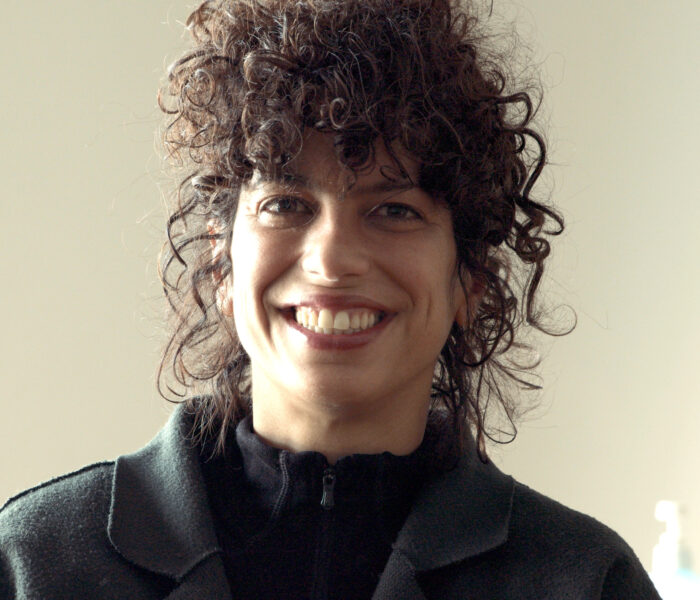En ce tout début juillet, le pianiste Benoît Delbecq m’accueille dans son jardin à Bondy. Les journées précédentes ont été denses : sessions de jeu, mixages d’albums, écriture… Benoît Delbecq est un hyperactif ! Cette discussion à bâtons rompus s’apparente à une trêve, comme peut l’être son activité d’ingénieur du son entre deux moments de composition et de travail du piano. Benoît Delbecq a beau aimer la fièvre du concert, il sait aussi que ces échappées sont salutaires.
Benoît, ces derniers mois ont été denses. Tu as donné en mars deux concerts à la Boulez-Saal de Berlin. Tu as pu y présenter deux nouveaux groupes : un trio avec Taylor Ho Bynum et Sarah Murcia, et un quartet avec deux musiciens suédois et le jeune batteur belge Samuel Ber. Quel a été le point de jaillissement de ces deux créations
Le responsable de la programmation berlinois m’a demandé des choses complètement inédites. Je me suis livré à un travail de réflexion à quatre mains avec lui. Dans les combinaisons que j’ai pu proposer, il y a des musiciens avec qui j’avais déjà travaillé, mais qui pour autant n’avaient jamais joué ma musique, sauf peut-être Taylor le cornettiste.
Sarah n’avait jamais joué avec Taylor et n’avait jamais joué ma musique.
J’ai aussi proposé un quartet avec le contrebassiste suédois de Berlin Petter Eldh, le saxophoniste suédois Otis Sandsjö, également actif à Berlin, et le batteur Samuel Ber, qui joue déjà dans Kartet. Peter et Otis sont très proches, et le fait de jouer ma musique a fait basculer leurs habitudes. J’aime venir colorer l’univers d’improvisateurs par une écriture qui donne un son de départ.
Quant à Samuel Ber, j’ai fait des sessions avec lui avant même qu’il n’intègre Kartet. Il a été mon étudiant au CNSMdP, où j’ai été invité par Riccardo Del Fra à enseigner la composition en 2016-17. Parmi les étudiants, il y avait aussi le bassiste Etienne Renard avec qui je joue aujourd’hui dans plusieurs groupes, et Samuel Ber : une belle bande de jeunes dont certains comme Etienne formés en un premier temps par Olivier Py, à Chalon sur Saône, et qui ont un savoir-faire incroyable, une belle fièvre, une incroyable précision de jeu. J’ai donc reçu une commande pour deux répertoires, le trio et le quartet, et je viens de mixer la musique. C’était toute une aventure, un processus sur la durée !
Le responsable de la programmation de la Boulez-Saal a-t-il pu te faire des suggestions ?
Oui, nous avions quelques envies communes.
Par ailleurs, pendant l’écriture, j’avais à l’esprit l’acoustique particulière de cette salle.
J’ai privilégié un jeu acoustique, et j’ai donc choisi Samuel dont le jeu pouvait s’accorder au piano préparé dans cette acoustique et dont j’avais envie de provoquer la rencontre avec le génial Petter Eldh.
Pour le trio, le choix de Taylor s’est imposé de lui-même. Taylor est un improvisateur que j’adore ! Il a une relation au timbre très forte, à l’espace aussi, et j’aime son jeu de sourdines.
Avoir Taylor dans cette salle-là, ça me faisait rêver. Quant à Sarah, elle voulait jouer mes compositions depuis des années ; c’était l’occasion ! Elle a aussi aimé l’idée de ne pas jouer amplifiée.
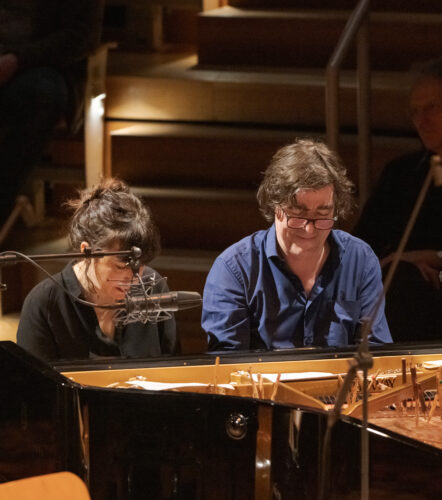
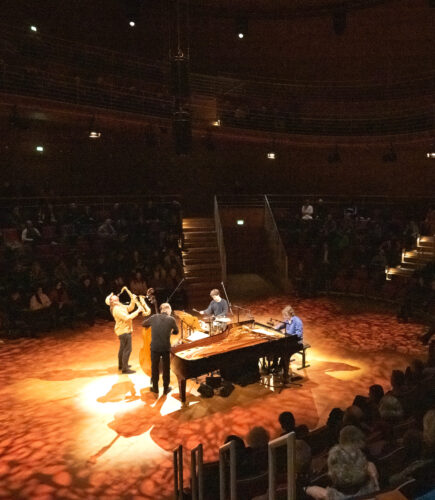

Quel a été le processus ?
Quand on écrit pour deux équipes comme ça, il y a une espèce d’arche temporelle qui se crée entre la pensée et le moment où l’on peut envoyer les partitions. J’ai passé des mois à prendre des notes, à écrire ce que j’avais envie d’entendre, de les entendre faire ensemble, à imaginer le “son vivant”, pour reprendre une formule de Messiaen, et à imaginer les comportements vivants.
C’est mon dada : mettre suffisamment d’éléments dans l’écriture pour typer l’altitude d’oreille. Ensuite, il y a eu un travail de projection mentale.
C’est à ce moment-là qu’on fait les choix, et les répétitions font encore bouger les choses. Quand je compose, je reprends toujours tout à zéro.
Je me demande : “c’est quoi la musique ? La pulsation ? Le son ? ”
Je tiens ça de mon beau-frère compositeur David Lacroix, qui a été aussi copiste autrefois. Il disait souvent : “ma vision de la modernité, c’est de remettre en question les outils à chaque travail”, et ça m’a marqué. J’essaie de faire ça, même si ma musique reste ma musique.
Pour écrire ta musique, tu utilises toujours des graphismes, des cercles et des calligrammes?
Oui, des cercles, des calligrammes, des compas, et des fichiers excel avec de petits carreaux : je fais des tissus, en fait, en 2D !
Et là je pense à la compositrice lituanienne Egedija Medekšaitė avec qui je viens de collaborer avec mon groupe Manasonics dans le cadre d’un projet de l’Ensemble l’Itinéraire. Je crois que j’ai découvert sa musique en faisant des recherches sur les tissus : tout ce qui est maillage, groupage, rythmicité, une matière organisée mais en apparence très libre, comme les tissus Kuba du Zaïre. J’ai pas mal lu là-dessus, et en cherchant je suis tombé sur sa musique. Il se trouve qu’elle est aussi ingénieure en conception de tissus : elle étudie les différentes dimensions qui opèrent dans la fabrication d’un tissu, et elle transpose ça en musique. J’y ai trouvé une correspondance avec une façon que j’ai de percevoir la musique, et de la fabriquer dans les phénomènes polymétriques. J’ai pu nommer les choses.
Dans le fichier excel, il y a des agencements de micros rythmicités.
Je fais des copié-collé, comme du cut-up en poésie (collage de mots). Je superpose, j’imprime – parfois deux fois sur le même papier – et j’observe. Je ne suis pas du tout un théoricien : je ne cherche pas à établir des systèmes infaillibles.
Ce qui m’intéresse, ce sont plutôt les systèmes qui ont un problème (rires). Il y a toujours un aspect primitif et artisanal chez moi. J’observe des suites de nombres, des architectures, tout ce qui a des proportions finalement !
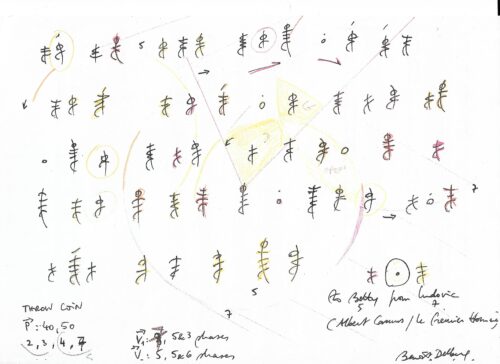
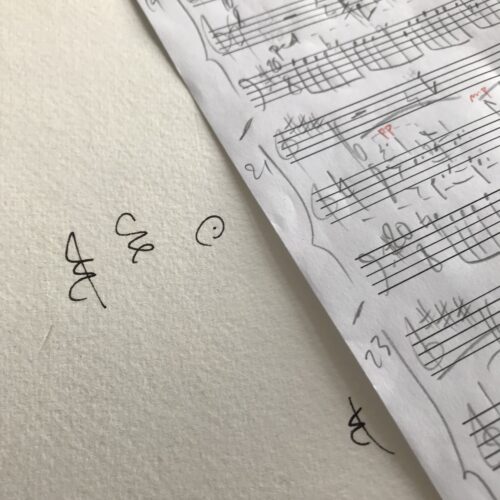
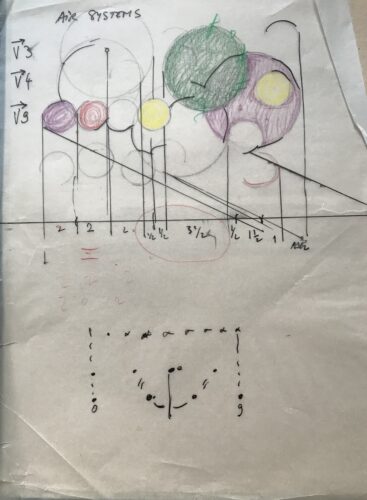
Mais tu apportes quand même des partitions aux musiciens, avec des notes de musique ?
Bien sûr ! Ils ont toujours des notes, même si avec Sarah et Taylor (lui qui a bossé des années avec Anthony Braxton), on a fait aussi quelques partitions graphiques. En général, le travail de dessin que j’évoquais à l’instant n’est qu’un lanceur d’activité. Au bout d’un moment, je prends du papier à musique et j’arrive avec du matériau. Cependant ce ne sont jamais de gros trucs. Un morceau, c’est souvent une ou deux pages, pas plus. C’est mon côté jazz !
Pour faire la place à l’improvisation ?
C’est ça qui m’intéresse le plus évidemment, même s’il m’arrive aussi de composer des pièces intégralement. J’y prends de plus en plus goût à vrai dire. C’est plus contraignant en termes d’aménagement de l’agenda, mais j’aime ça.
Quand je compose, je ne peux plus voyager pour des concerts, mais j’aime me retrouver en état d’écriture très concentré, ici, dans ce jardin ou dans ma cuisine. En ce moment, je travaille sur un court quatuor de 2 minutes pour un concert de la BBC. C’est une commande du Quatuor Ligeti pour le centenaire de la naissance de György Ligeti. Je serai l’un des douze compositeurs engagés dans l’histoire, en plus de Lukas Ligeti, son fils, qui a écrit une pièce plus longue. Je compose cette page à partir d’une étude de Ligeti. C’est une mise en loge de quelques jours. J’ai le synopsis, maintenant il faut rédiger…
J’ai beaucoup écrit cette année. J’aime beaucoup cet état ! C’est une autre vitesse de pensée que le concert. De fait, je bouge moins depuis le covid. J’envisage maintenant plus cette situation de composition. Et en même temps, mon activité principale c’est quand même d’être sur scène et de jouer, d’inventer avec des ami·e·s !
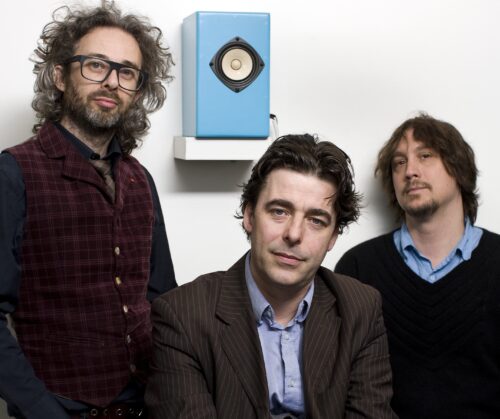
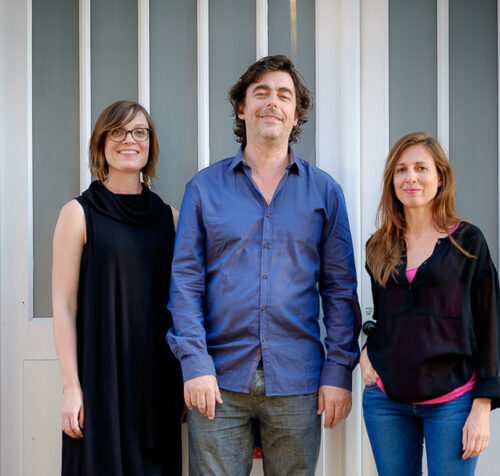
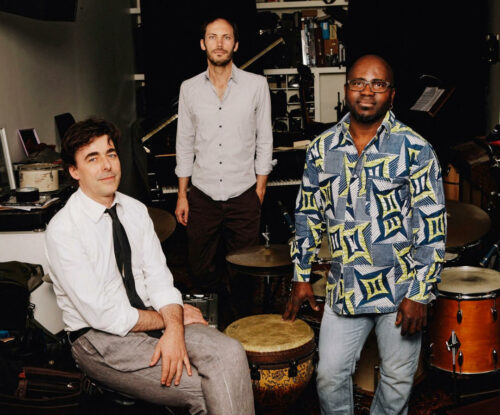
Il y a eu un impact à long terme du covid sur tes tournées ?
On a pris cher ! On a eu des soutiens, mais le réseau a souffert : les petites salles notamment. Aux Etats-Unis c’est désastreux, et en Grande Bretagne aussi, sans parler du brexit ! La scène anglaise est presque détruite. Depuis le brexit, je n’y ai pas joué; ça a tout changé.
On a encore un réseau, mais il est saturé : il y a un monde fou, et de très haut niveau. On se trouve en réalité dans une situation de surproduction !
On ne l’a pas vraiment vu venir, même si l’idée m’a effleuré, au moment où s’ouvraient toutes les classes de jazz ! Et je ne parle que du jazz là ; en musique contemporaine, c’est même encore plus difficile !
Dans le jazz est apparu un esprit de concurrence et un rapport au show business, que je trouve très décevant, si je compare à ce que j’ai vécu autrefois.
Chez les musiciens de ma génération, pendant 25 ans ou 30 ans, on avait cette sensation de communauté, de grande famille, la famille de l’improvisation et du jazz, avec bien sûr des vases communicants : en ce qui me concerne, des saillies vers la musique contemporaine, et un peu de pop.
Aujourd’hui, je trouve qu’on est beaucoup plus dans la communication, dans l’enveloppe des choses, le “faire savoir et le savoir-faire” pour reprendre l’expression de Godard !
Par conséquent, c’est devenu plus difficile de tourner, voire quasi impossible en France. Tout se complique !
Heureusement, au moment du confinement, on a fait beaucoup de sessions à Bureau de Son, car on a notre propre studio. On a pu développer le répertoire du trio Triple Fever, et celui de mon nouveau sextet The Multiplexers avec Alain Vankenhove, Samuel Blaser, et trois jeunes musiciens Etienne Renard, Charley Rose, Samuel Ber : ça m’a permis d’établir un pont avec les générations plus jeunes. Moi aussi dans ma jeunesse, j’ai été pris sous les ailes de musiciens plus expérimentés : c’est une forme de continuité qui me plaît ! Le sextet a joué une fois au Triton en janvier (un concert unique), mais j’ai un enregistrement formidable (ci-dessous un extrait en exclusivité, ndlr) !
Dans ce groupe, il y a une forme d’écoute spécifique, de gourmandise à se découvrir. Les comportements ne sont pas les mêmes d’une génération à l’autre.
Le problème est que je ne suis pas sûr qu’on puisse continuer à jouer : on est six gars, c’est difficile à vendre aujourd’hui !
À ce sujet, comment te positionnes-tu sur la question d’une recherche de parité dans le jazz? Si l’on regarde ton parcours sur la durée et tes collaborations, on rencontre peu de musiciennes en dehors de Sarah Murcia, Claudia Solal et Elise Caron ?
C’est vrai, même si je dois beaucoup à certaines figures de femmes musiciennes.
Avec la comédienne Marie Dompnier et le metteur en scène Jan Peters justement, on prépare un spectacle sur les femmes artistes qui ont été empêchées de créer. Le personnage principal est une femme qui a existé, qui a été empêchée d’exercer le théâtre et l’écriture, et qui a fini à l’asile. On a déjà commencé à travailler ensemble. C’est un travail de co-écriture. On sera en résidence à l’Aquarium à la Cartoucherie en novembre.
Mais c’est un fait ; si l’on regarde mes groupes instrumentaux, il y a une dominante masculine, en dehors de Claudia Solal, Sarah Murcia, Elise Caron … et aussi maintenant de la claviériste Maïlys Maronne, qui joue dans le Quartet Orytmy avec Toma Gouband et Magic Malik.
Tu sais, quand j’ai enseigné au CNSMdP pendant un an, il n’y avait dans la classe qu’une seule étudiante sur 51 élèves ! Ceci dit, je trouve qu’il y a quand même dans les dispositifs sur la parité une forme de brutalité, et qu’on ne part pas à compétences égales …
C’est compliqué cette histoire, car finalement les bonnes improvisatrices en France, elles jouent tout le temps, elles ne sont pas libres en fait ! On pourrait en citer plusieurs.
Pour être honnête, quand j’ai choisi les musiciens du sextet, c’est vrai que je n’ai pas pensé à ça. J’ai spontanément appelé des musiciens avec qui j’avais envie de jouer, pour des raisons d’évidence, de complicité.
Mais force est de constater qu’en Scandinavie, où ils ont entrepris ce travail de parité il y a quarante ans, la situation a beaucoup évolué et qu’il y a beaucoup plus de femmes, y compris sur la scène du jazz, ce qui est loin d’être le cas en France. Nous recevons des injonctions des organismes d’aides tels que la DRAC, donc ça s’équilibre, peu à peu.
Je pense à Ingrid Laubrock, la saxophoniste allemande installée aujourd’hui à New York, une des figures de la scène du jazz international, et qui écrit sa musique : c’est quelqu’un qui va forcément créer des vocations, comme Joëlle Léandre l’a fait avant elle.
Ma vocation à moi, je la dois en grande partie à Mal Waldron, mais c’était un homme !
Ceci dit, ma professeure de composition au conservatoire de Versailles autrefois, Solange Ancona, décédée il y a deux ans, a été une présence très importante dans ma vie de compositeur. Le fait qu’elle ait été une des seules femmes compositrices à l’époque de Darmstadt était tout sauf banal. Des fois, elle faisait remonter des petites histoires… Ce n’était pas une situation facile à vivre. Elle a dû se frayer son chemin. Avec son savoir-faire et ses connaissances, elle a été une personne féminine très forte dans ma vie de musicien. Mais dans le jazz, il y en a moins, c’est un fait !
Est-ce qu’on peut évoquer un épisode récent de ton activité de musique : la collaboration avec l’Itinéraire. C’était la première fois que tu collaborais avec un ensemble de musique contemporaine ?
Oui ! La rencontre avec l’altiste de l’ensemble, Lucia Peralta, s’est faite grâce à une amie d’enfance. Elle m’a présenté à Grégoire Lorieux. J’ai donné quelques disques, et ils ont écouté ma musique. Ensemble, on a eu l’idée d’associer les musiciens de l’Itinéraire et du trio Manasonics avec Steve Argüelles et Nicolas Becker.
À ce moment-là, j’ai découvert la musique de Egedija Medekšaitė, et j’ai suggéré qu’on lui commande une pièce. J’ai aussi proposé d’écrire moi-même une pièce. L’itinéraire a eu l’idée d’ajouter une œuvre de Scelsi. Le programme est complété par une pièce pour deux pianos de Egedija Medekšaitė que je joue moi-même, avec un disklavier qui joue tout seul !
Tu peux nous en dire plus sur Egedija Medekšaitė ?
On ne s’est jamais rencontrés, sauf sur zoom !
Elle a une quarantaine d’années. Elle vit dans le nord de l’Angleterre où elle enseigne. Elle s’y est installée, après son doctorat. Elle écrit une musique assez étale, mais qui se développe selon des principes de tissage. Selon sa manière d’incrémenter son écriture, ça se retrouve sur la couleur des timbres ; c’est de la mélodie de timbre, à laquelle s’ajoutent des tissus qui se développent dans la verticalité. On a enregistré la répétition ; elle était très heureuse de cette collaboration ! C’est une musique surprenante : parfois répétitive, avec de micros décalages, qui peut déstabiliser les interprètes. De mon côté, j’ai écrit deux pièces : une pour l’Itinéraire, une pour Manasonics, et puis on va improviser ! Ce sera créé à l’automne, le 30 novembre, à l’Atelier du Plateau à Paris. Pour le moment, nous n’avons pas d’autre date en France. On jouera aussi à Belfast et en Belgique.
J’aime le travail avec des musiciens tels que ceux de l’Itinéraire, notamment l’altiste Lucia Peralta, qui joue toutes sortes de musiques, et pour qui la pratique instrumentale n’est pas une fin théorique en soi. Je dis souvent quand j’enseigne : “Le premier boulot du pianiste, c’est de faire sonner les autres !”
Depuis longtemps, parallèlement au piano préparé, tu as développé un goût pour l’électronique, qu’on perçoit à travers la musique de tes duos avec Steve Argüelles et Jozef Dumoulin : Ambitronix et Plug and Pray ? C’est venu comment cette fascination pour l’électronique ?
C’était là dès l’adolescence !
J’avais arrêté le piano classique à 11 ans, puis repris vers 12 -13 ans avec des copains de quartier, dont un batteur : on faisait de la pop – des reprises de The Police (rires…). J’ai encore les K7 ! Adolescent, j’ai eu une fascination pour les claviers, les synthés !
Un jour, je passe par hasard chez le compositeur Maurice Lecoeur (auteur de musiques de film), à Ville d’Avray. Il avait le dernier Prophet 5, la 808 : tous ces trucs qu’on allait voir dans les vitrines à Pigalle parce qu’ils coûtaient très chers !
Donc je me suis acheté d’abord un Fender Rhodes – que j’ai remboursé en baby sitting – puis un dx7. Comme j’ai fait un bac scientifique, les algorithmes ça m’intéressait ! Je me suis retrouvé à programmer ce synthé. Je connaissais un élève de Jean Schwarz, et j’allais faire des boucles avec les pieds de micros. J’avais entre 15 et 17 ans.
Ensuite, j’ai fait des études de sons – c’est mon seul diplôme d’ailleurs, car je n’en n’ai pas en musique – et j’ai toujours gardé une oreille sur les micros !
Puis il y a eu la rencontre avec Thierry Balasse et Etienne Bultingaire, formés par Daniel Zalay. Le son de France Musique a formé mon oreille aussi : en particulier la musique de chambre. J’ai toujours écouté la radio : c’était comme être à la maison ! La découverte des outils pour produire cet effet de géographie du son m’a plu, et m’a rapproché de cette profession, même si je ne veux pas l’exercer.
J’aime mixer des disques. De plus en plus, j’offre mes oreilles aux musiciens, et on me demande de mixer des albums. J’ai fait des études d’ingénieur du son. J’ai commencé à mixer seul, à la mort d’Etienne Bultingaire. Il y avait une telle empathie entre nous, on s’est tellement appris ! Les derniers temps de sa maladie, il venait trois heures, puis devait se reposer et souvent repartir avant la fin. Je finissais moi-même le travail, et j’avais son aval pour le faire. Je l’avais tellement vu faire ! Aujourd’hui, si j’ai un doute sur un mix, je réécoute un truc fait avec lui ou qu’il a fait seul : c’est comme une piqûre de rappel.
En fait, j’aime la géographie du son. C’est passionnant, car cela influe aussi sur le son qu’on émet après. Quand on s’entraîne à l’acuité de l’écoute, on la retrouve dans la production du son, et ça ouvre la palette au moment du jeu.
On me demande mes oreilles, de plus en plus ! Je dois dire aussi que j’aime être à mon studio (Bureau de son) à Paris pour faire ça. Cela me donne l’occasion de voir mes enfants. De plus, dans ce studio j’ai mon vieux Steinway : je suis toujours heureux de le retrouver ! Mixer un disque me repose du piano. Quand on joue beaucoup, on peut saturer. Cette année par exemple, j’ai beaucoup joué et préparé mon piano. Il y a les douleurs aux mains, les échéances… Le mixage est une parenthèse : ça me permet de souffler.
PLUG AND PRAY (Benoît Delbecq & Jozef Dumoulin) – EVERGREENS from Igor Juget on Vimeo.
Le travail du piano et des préparations, c’est physiquement très exigeant ?
Oui, d’autant qu’au piano, je suis un peu un tâcheron. Comme j’ai une technique tardive, j’ai toujours besoin de vérifier que ça marche ! J’étudie des heures quotidiennement. Ne serait-ce que pour les pièces nouvelles que je prépare, avec des polymétriques particulières. Je ne les joue pas à froid, je m’entraîne pendant des heures, pour que ça devienne des tissus que je maîtrise, pour que je puisse choisir la couleur du fil et changer de point en cours de route. Pour ça le solo, c’est la liberté totale, mais ça représente toujours un temps de préparation dément pour que ce soit facile !
Et puis je travaille toujours la phrase, souvent dans des contextes de bop; le placement de la phrase, ce que j’appelle la rythmicité générale. Je travaille des cadences sur des temps longs (deux heures). C’est infini comme source de travail !
C’est un truc de pâte à modeler, de levier du bras. Je travaille toujours ça : j’ai repris des cours il y a à peine dix ans avec la pédagogue de New York Sophia Rosoff. Quand elle m’a dit le mot “levier du bras”, ça a changé ma vie de pianiste. J’ai eu le sentiment de reprendre à zéro ! On ne me l’avait jamais montré, et comme j’ai pris peu de cours dans ma vie de pianiste, il y a plein de choses que je ne sais pas faire… Du coup, des fois je les comprends chez les autres, et je me demande “comment ils font ” ?
Je suis allé voir le pianiste Jay Gottlieb, et Sophia Rosoff quelques années plus tard. Dans ce cas, j’en reprends pour dix ans et je le fais volontiers : c’est un plaisir de pouvoir progresser dans un son ; ça veut dire que la recherche continue ! Car ma démarche à moi, c’est de la recherche ! Il y a ce truc d’enthousiasme à chercher, de laborantin…
J’évoquais à l’instant le solo, mais jouer avec d’autres c’est capital !
Le duo avec Claudia Solal est très important pour moi. Quand on joue ensemble, Claudia improvise sur ses textes. On travaille sur un prochain disque qui mélangera ses textes et mes textes.
Le duo avec Elise Caron, c’est différent ; c’est beaucoup plus théâtralisé, les textes sont improvisés par Elise !
Et là, on vient d’enregistrer un nouveau répertoire avec le clarinettiste François Houle. Quel plaisir de le retrouver ! Il a une nouvelle clarinette, faite sur mesure, et ce qu’il fait avec cet instrument est incroyable. On joue dans la même pièce, mais on a l’impression – comme avec les chanteurs diphoniques – que le son sort des murs : du jamais entendu pour moi !
Tant qu’on peut aller chercher des sensations pour lesquelles on n’a pas encore le nom, j’y vais allègrement ! Cette saison, il y a eu des moments extrêmement heureux de partage, comme les concerts en mars à Berlin, avec tous ces musiciens qui arrivaient pour les répétitions : une vraie joie familiale. D’autant que dès les premières notes, ça joue terrible ! Donc j’ai réécouté ce concert avec bonheur. Je pense que je vais le publier, parce que c’est très bien enregistré !
On évoque justement les activités du label dStream de la coopérative Le Bureau de Son ?
On sort peu de nouveaux albums avec Le Bureau de Son.
Le prochain album, ce sera le Bumper trio, avec Sarah Murcia, Steve Argüelles et moi-même, où Sarah ne joue que du synthé basse : je suis très content de ce groupe aussi !
Avec Triple fever, y a un album qui est prêt, un autre aussi avec François Houle.
Alors sans doute, cela fait trop d’albums à sortir, mais comme de toutes façons les albums atteignent des visibilités quasi nulles, je vais tout sortir, en numérique – et peut-être les Multiplexers ou Triple fever en vinyle – même si c’est beaucoup de boulot de sortir des disques, car je fais tout, les mix et aussi le mastering !
En fait, je travaille tout le temps, et puis j’ai trois enfants, donc travailler est une nécessité économique. Je n’ai jamais d’argent devant moi, mais je bosse tout le temps, c’est inimaginable !
Il arrive qu’on joue pour très peu d’argent, mais quand on le fait c’est pour de bonnes raisons. Je pense au solo que j’ai donné lors de la série de concerts de Gaël Mevel, La Maison-en-bois et la Compagnie Rives : un piano merveilleux, un accueil de rêve, et une vraie écoute du public. On ne regrette jamais d’avoir accepté de tels moments, à cause de la fièvre du jeu ! Il me semble qu’on sent moins la fièvre au concert.
Tu l’attribues à quoi ? Aux difficultés économiques seulement ?
Je crois que ça vient de la multiplication des sources. Les jeunes ont trop de choses à écouter (playlists), sans être forcément guidés dans l’écoute. Il faut échanger avec ceux qui ont de l’expérience, écouter les émissions radio, aller au concert… elle est là la musique !
Je pense souvent à cette espèce de fièvre qu’on avait nous – ou alors c’est parce que moi j’avais un âge fiévreux ! Je me souviens par exemple de concerts d’Ornette Coleman à Banlieues Bleues, ou de la première des pièces pour deux pianos de György Ligeti au Foyer du Châtelet : là, tu sentais une espèce d’impatience !
Je sens moins l’impatience chez la jeune génération, parce qu’ils voient beaucoup de choses en images, et c’est toute la différence, qui sait ! A l’âge que j’ai, je suis finalement un des derniers qui n’a pas “appris” avec l’image. Quand internet arrivait, j’avais déjà 28 ans ! Ceux qui sont nés 5 ans après, ont eu déjà cette culture de l’image : tel gros plan sur les mains de Bill Evans par exemple !
La première fois que j’ai vu Monk jouer, c’était le jour de sa mort. La télévision française avait fait un petit sujet à la fin des infos, et là je vois “Monsieur Monk” – on l’appelait comme ça à la maison, mon père avait des disques de lui. Je me souviens, je devais avoir 15-16 ans : c’étaient des images d’à peine vingt secondes. Je l’ai vu croiser les mains, faire des trucs bizarres, et je me suis dit : “on a le droit de faire ça“ !
Les générations d’après ont tout de suite vu ça. Voir Monk, Ahmad Jamal, Fred Van Hove faire ça, c’est normal pour eux ! Voir Cecil Taylor en solo, c’est normal : c’est à la télé ! Bien sûr, ça en a construit beaucoup, mais d’autres ne s’en sont jamais sortis.
Quand tu es trop dans la copie et le mimétisme, c’est un gros problème ! Aujourd’hui, il me semble que la fièvre n’est plus dans le fait d’inventer sa voie, elle est dans le fait d’être “dans l’air du temps” et à la mode. Cette notion de paraître est devenue très présente sur la scène, et c’est très désemparant !
Après tout, on peut être musicien de jazz, et se nourrir de bien d’autres choses que le jazz, lire Boulez et Messiaen par exemple, et s’intéresser à leurs travaux.
Tous les termes que j’utilise dans ma musique (par exemple la rythmicité) ça vient de Solange Ancona qui était élève de Messiaen. Quant à l’idée de recherche d’un folklore imaginaire, je la dois bien sûr à Bartok mais aussi d’une certaine façon à l’ARFI lyonnaise : chacun invente son jazz !
Quand j’avais 17-18 ans, cette notion de folklore imaginaire a été très fondatrice. Moi, petit blanc de la région parisienne, je me suis interrogé sur mes origines, sur le folklore de ma famille du Nord-Pas-de-Calais : quelques éléments d’éducation catholique, mais à part ça, quel folklore ? Il fallait l’inventer. Il a fallu créer une insularité à partir de mon background assez classique (les Bowie, Pinkfloyd, The Clash …). Finalement, qu’est-ce qu’un folklore imaginaire ? Qu’est-ce une langue imaginaire et qu’est-ce que la fiction en musique ?
Ce ne sont pas des interrogations si répandues dans l’univers du jazz. Je reste un peu à part !
Moi, j’adore la pulsation : j’adore la manipuler, la triturer, déployer un jeu d’illusion sonore, et que ça rebondisse à des endroits… D’autres musiciens n’entendent pas ça et je le respecte! D’ailleurs, beaucoup de musiques sans pulsation m’intéressent.
Quand je jouais dans le Celestrial Communication Orchestra de Alan Silva à 18 ans, quand il y avait une ligne de basse qui apparaissait à un moment et que ça tournait, c’était le bonheur ! Mais après on faisait aussi des trucs complétement free, des matières…
Je suis marqué par les deux. Le côté pulsatif des concerts d’Ornette ou même les débuts de Steve Coleman, où personne ne bat du pied pareil, j’adore ! C’est pour ça que j’écris de la musique comme ça. Chacun choisit son pouls, après tout !
Il y a aussi de la fragilité dans la pulsation ? Chez Monk par exemple ? Ses fameuses hésitations ?
Bien sûr, et ça se fabrique la fragilité ! Ce sont de petites usines à fragilité quand même… Quand on est jeune musicien et qu’on écoute les figures marquantes, qu’on suit l’évolution d’un musicien comme Monk, on peut voir par exemple que le silence prend de plus en plus d’importance dans sa musique avec le temps. C’est de la rythmicité générale !
C’est comme observer la rythmique de la langue de Proust, ou de Cadiot avec qui j’ai travaillé, ou de Roubaud. Pour moi, c’est là que ça se passe ! Finalement, c’est le détail dans le rebond, que le temps soit mesuré ou non. La barre de mesure n’est pas ma grande copine. Dans ma musique, il y a une sorte d’abolition de la barre de mesure, un peu comme quand on écoute une fugue : on n’aura jamais deux fois la même écoute, selon qu’on se focalise sur tel ou tel élément. C’est comme des portes qui s’ouvrent et qui se ferment!
Plus la musique est riche de ça, plus elle est sujette à une construction possible : c’est une sorte de rhétorique ludique, qui contient plein de choses pour les oreilles, car finalement c’est ça qu’on veut, nourrir nos oreilles !
Benoît Delbecq – The Loop of Chicago from Igor Juget on Vimeo.
Propos recueillis par Anne Montaron
Crédits © John Rogers
Crédits © Valérie Acheno
Crédits © Laurent Poiget
Crédits © Jacop Tillmann



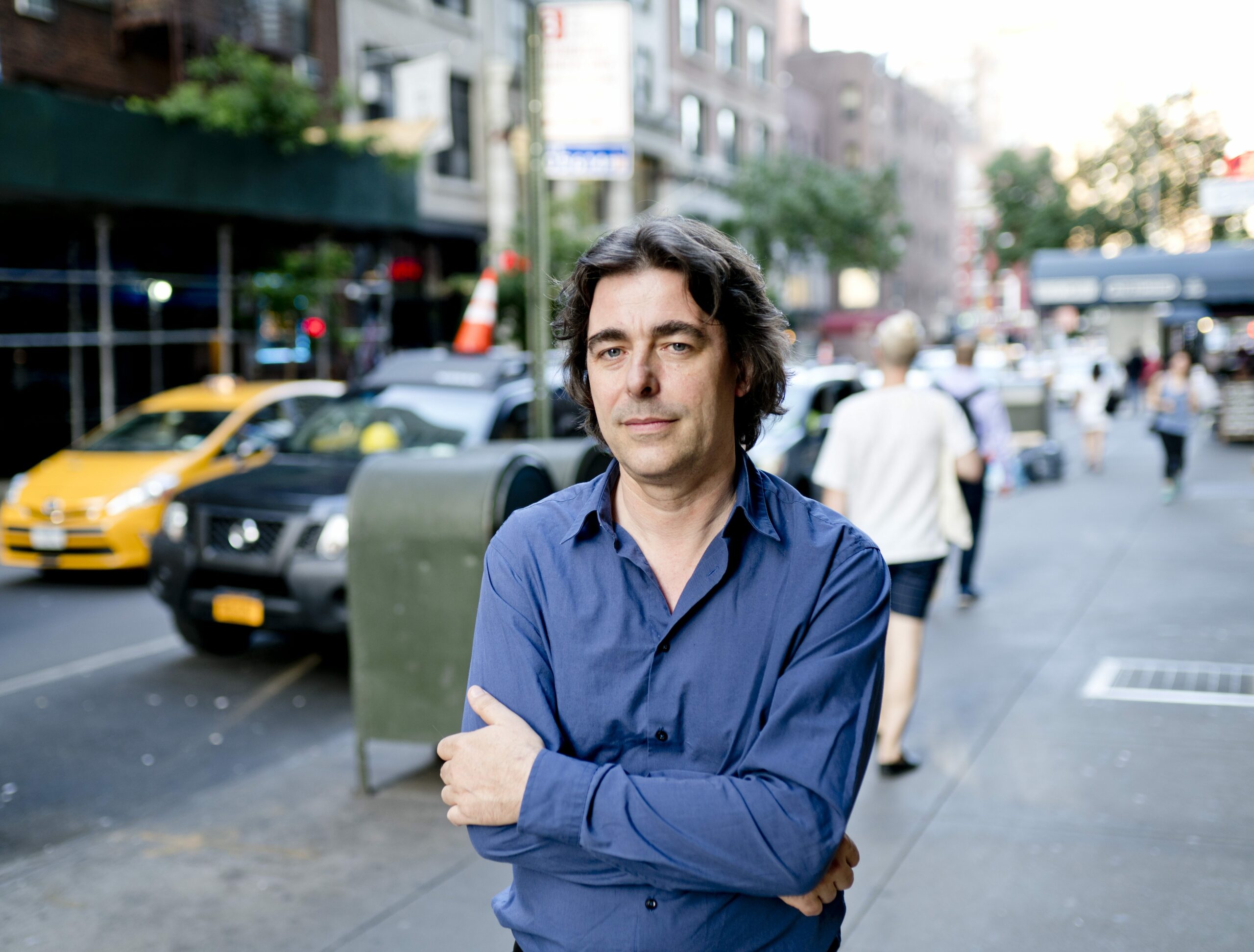)

